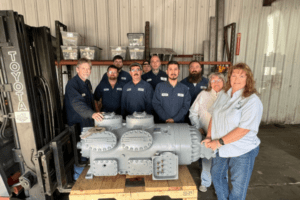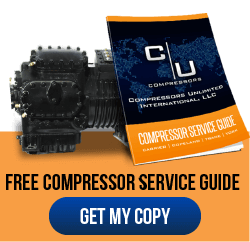
Commercial refrigeration systems and equipment should be maintained regularly for optimal performance. Manufacturers also require consumers to ensure their systems undergo regular scheduled inspections to maintain the original equipment manufacturer (OEM) warranty.
Supermarkets, refrigerated warehouses, convenience stores, and other establishments with commercial refrigeration systems should ensure corrective actions in form of scheduled inspections, maintenance, and remediation are undertaken as required
Below is a maintenance checklist of tasks that should be undertaken to keep commercial refrigeration equipment in optimal form.
Monthly Maintenance Tasks
Liquid Overfeed System
- Check the pump motor, starter, and wiring, and repair them as necessary.
- Ensure that the pump and motor are operating within the manufacturer’s limit. If the two are operating outside the limits, determine the causes and remedy.
- Test and adjust the pump safety cut-off.
Programmable Logic Controller (PLC)
- Test and calibrate the refrigerant monitor.
- Check, test, and log the alarms.
- Check the outside communications (BMS, alarm monitoring system, etc.) and advise as appropriate.
Compressor Package – Compressor
- Check the deal drip count. If the drip count is more than that recommended by the OEM, replace the seal.
Quarterly Maintenance Tasks
Compressor Package – Oil Circuit
- Check the operating time of the refrigeration system. Carry out oil analysis, change the oil filter and strainer, and replace the oil as recommended for every service interval.
Various Refrigerant Transfer Vessels
- Check the vessel transfer valves for integrity and insulation. Ensure they are operational in manual mode. Test and repair them as necessary.
- Check the vessel and piping for refrigerant leaks.
Liquid Overfeed System
- Check the general condition of the piping and insulation. Also, inspect the piping refrigerant leaks and repair or replace, as necessary.
- Check the low side receiver fill valve and evaporator feed valves. Test for cut in and cut out and proper operation, respectively.
- Test and adjust the minimum flow device.
Rack – Power ON, System Running
- Check the lubricant level in the compressor, level at the reservoir, and supply pressure. Record and compare it to the baseline level.
- Check the pressure drop across the lubricant filter. Replace is the drop exceeds OEM limits.
- If the system is equipped, check the refrigerant level in the receiver or sight glass and compare it to the baseline level.
- Check compressor cooling devices (demand cooling and head fans) and whether the system has excessive vibration. Repair, secure, or replace the parts as needed.
- Adjust, repair, or replace the de-superheater, sub-cooler, and defrost-pressure differential valve as necessary.
Compressor Package
- Check for refrigerant and oil leaks, and repair as necessary.
- Check the operating time of the unit and replace the coalescing element, liquid line strainers, suction screen, and motor compressor as required in the service manual.
Compressor Package – Controls
- Recalibrate the RTD sensors and transducer as necessary.
- Pull or download control data and alarms. Log and take appropriate corrective action.
- Ensure that the wiring is proper and provide any support as needed.
Compressor Package – Compressor
- Inspect the motor wiring and starter, and tighten the connections or replace as necessary.
- Inspect and adjust the compressor unloading.
Evaporative Condenser – Motor and Drive
- Check, lubricate, and clean the motor. Also, check the mounting and replace it as necessary.
- Check the condition of the belts and replace them as necessary. Adjust the tension and alignment for optimal performance.
- The sheaves and pulleys should be cleaned and repaired or replaced, as necessary.
- Tighten and secure the connection wiring (electrical whips).
- Record motor vaults and amperages values to see whether they fall within range.
- Ensure protective guards are properly installed.
- Clean, repair, and lubricate the gear driver unit (gear coupling/system) as necessary.
Evaporative Condenser – Water Circuit
- Inspect, clean, and repair or replace the spray distribution, pump, and piping as necessary.
- Check make-up water and bleed rate. For these, clean the strainer, or adjust and repair as necessary.
- Confirm whether the water treatment system is operational.
Programmable Logic Controller (PLC)
- Test and repair the alarm annunciator.
Annual Maintenance Tasks
Evaporative Condenser – Water Circuit
- Clean, brush, and flush the sump basin to ensure it is free of dirt and debris.
Evaporative Condenser – Other
- Check the low ambient protection (basin heater) before winter and repair it as necessary.
Compressor Package
- Check oil connections and LP/HP control piping for oil leaks. If you detect oil, check whether there are any refrigerant leaks. Alternatively, replace the tubing by following the OEM instructions.
Compressor Package – Oil Circuit
- Check the oil pump wiring and starter as applicable. Repair or replace malfunctioning starters.
Compressor Package – Controls
- Check the set points and ensure they are in the correct settings.
Programmable Logic Controller (PLC)
-
Test and calibrate the RTD Sensor and transducer.
- Replace the refrigerant monitor filter.
- Test the auxiliary power supply within date to ensure it is functioning properly. Repair or replace it as necessary.
- Check the defrost and space temperature and adjust as appropriate.
Follow the above commercial refrigeration systems maintenance checklist to keep your equipment in top form.












